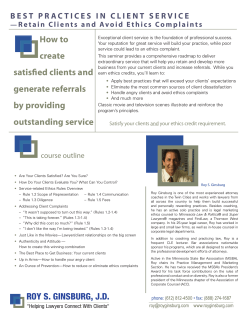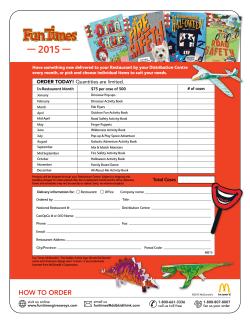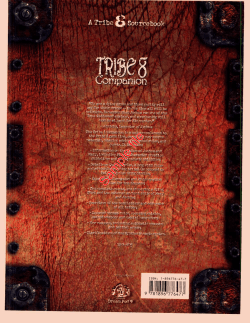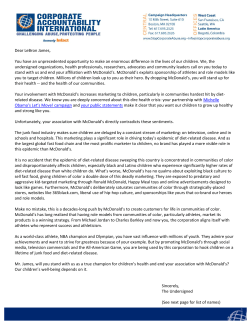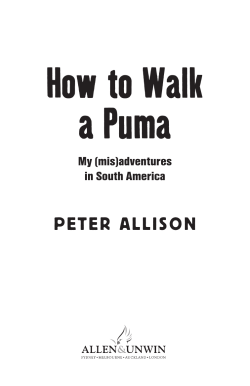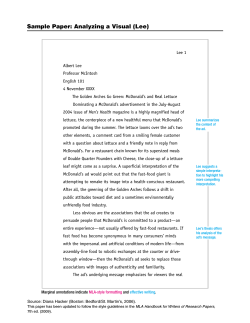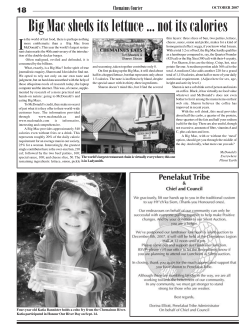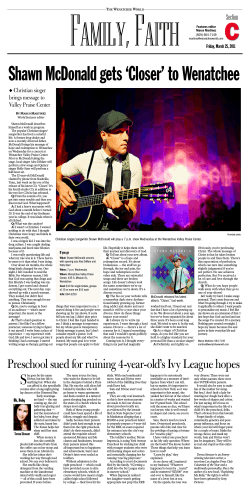
McDonald’s Corporation A Strategic Management Case Study mcdonalds
McDonald’s Corporation A Strategic Management Case Study www.mcdonalds.com/ Matthew O’Malley Spenser Ouellette Kristi Plourde Robert Roy Overview Company Overview A Brief history of McDonald’s Existing Mission and Vision Existing Objectives and Strategies Current Issues New Mission and Vision External Assessment Industry analysis Opportunities and threats EFE Matrix CPM Matrix Strategy Formulation SWOT Matrix Space Matrix IE Matrix Grand Strategy Matrix Matrix Analysis QSPM Matrix Strategic Plan for the Future Objectives Strategies Implementation Issues Internal Assessment Strengths and weaknesses Financial Condition IFE Matrix EPS/EBIT Evaluation McDonald’s 2008 Update O’Malley, Ouellette, Plourde, & Roy 2009 2 Who We Are •Headquartered in Oak Brook, Illinois. •World’s largest foodservice retailing chain. •Known for its burgers and fries. •Offers a standard menu at all locations, though some locations may have some variation based on geographic variations in taste preference. •Operates over 31,370 fast food restaurants in over 118 countries, employing 390,000 people. •A majority of the restaurants are operated by franchisees. •McDonald’s owns the land used for each of the franchises, then builds and secures a long-term lease for the restaurant site. •Franchisees then provide a portion of capital by investing in the equipment, signs, seating and décor of their restaurant business. •The company also operates restaurants under the brand name 'The Boston Market‘, acquired in May of •O’Malley, Ouellette, Plourde, & Roy 2000. 2009 3 What We Sell O’Malley, Ouellette, Plourde, & Roy 2009 4 Where We Are O’Malley, Ouellette, Plourde, & Roy 2009 5 History •Dec 1948: The first McDonald’s restaurant is opened in San Bernardino, California by brothers Richard and Maurice McDonald. Offers burgers, fries, milk shakes, soft drinks, and apple pie. •1954: Ray Kroc, a milkshake machine salesman, suggests nationwide franchising and acts as a franchising agent for the brothers. •1955: The first restaurant run by Ray Kroc opens in Des Plaines, Illinois. Several problems arise in adapting the system used by Richard and Maurice to the new restaurant. First logo, Speedee, is introduced. •1956: Kroc has to repurchase the franchise rights for the Cook County restaurant. They had been previously sold to the Frejlack Ice Cream Co. Fred Turner is hired to oversee operations. •1957: Year-end sales for close to 40 restaurants- almost $4.5 million. •1958: The 100 millionth hamburger is sold. Sales top $11 million. There are 34 restaurants in existence. O’Malley, Ouellette, Plourde, & Roy 2009 6 History (cont.) •1959: Kroc opens 67 new restaurants, bringing the total to 100 franchises. They begin advertising on billboards. •1960: Look for the Golden Arches becomes the new slogan. Fifth anniversary of the company is celebrated, and the 200th restaurant is opened. Sales reach $38 million. •1961: Kroc buys out the McDonald brothers for $2.7 million and opens his first Hamburger University, for the training of franchisees •1962: The Speedee logo is replaced by the Golden Arches as the company logo. Advertises nationally, for the first time, in Life magazine. •1963: The 500th McDonald’s is opened. The fish filet sandwich is added to the menu. Ronald McDonald is introduced. O’Malley, Ouellette, Plourde, & Roy 2009 7 History (cont.) •1965: Stock goes public in celebration of the 10th anniversary of the company. Ads start showing on network television. •1966: The first public shareholders meeting is held. Sales hit $200 million. •1967: The first restaurants outside the US open in Canada and Puerto Rico. •1968: The Big Mac is added to the menu. The 1,000th store is opened in Des Plaines. •1969: International division of the company is formed. McDonald’s is listed on the Midwest and Pacific stock exchanges. O’Malley, Ouellette, Plourde, & Roy 2009 8 History (cont.) •1970: The 1,500th restaurant is opened in New Hampshire. New advertising slogan becomes, You deserve a break today, so get up and get away to McDonald’s. •1971: Company headquarters are moved from Chicago to Oak Brook, Illinois. Restaurants are opened for the first time in Australia, Germany, Guam, Holland, and Japan. •1972: McDonald’s is a $1 billion corporation. Surpasses the Army as the nation’s biggest dispenser of meals. •1973: The Egg McMuffin is added to the menu as a breakfast item. •1974: The first Ronald McDonald House is opened. Sales approach $2 billion. Fred Turner is named President and CEO. O’Malley, Ouellette, Plourde, & Roy 2009 9 History (cont.) •1976: Sales exceed $3 billion, and the 4,000th store is opened. Directors declare the first cash dividend. •1977: A variety of breakfast foods are added to the menu. •1979: Happy Meals are added to the menu. Half of all stores have a drive-thru window. •1980: The 6,000th restaurant is opened. 25th anniversary is celebrated. Mike Quinlan becomes president and CEO of McDonald’s USA, which is a new position. •1981: The first restaurants are opened in Denmark, the Philippines, and Spain. •1982: Dividends per share rise by 32%. Mike Quinlan becomes president and COO as well as keeping his position with McDonald’s USA. O’Malley, Ouellette, Plourde, & Roy 2009 10 History (cont.) 1983: Chicken McNuggets are introduced on the menu. 1984: Ray Kroc, founder and senior chairman of the board of directors, dies. 1984: Year end sales pass $10 billion. Ed Rensi becomes president of McDonald’s USA. Open restaurants in Andorra, Finland, Taiwan and Wales, and the 8,000th restaurant is opened. 1985: The McDLT is introduced, a hamburger sold with lettuce and tomato in a separate compartment to keep them cool. 1986: McDonald’s offers comprehensive listings of ingredients in all its foods to the public. Mike Quinlan is elected CEO, and restaurants open in Argentina, Cuba, and Turkey. O’Malley, Ouellette, Plourde, & Roy 2009 11 History (cont.) •1987:Tossed salads are added to the menu, to satisfy the public’s desire for lighter, more nutritious fast-foods. •1988: An agreement is signed to build the first McDonald’s in Moscow. Sales exceed $16 billion. Restaurants are opened in Hungary, Korea, and Yugoslavia. •1990: The world’s biggest McDonald’s, with seating for 700, is opened in Moscow. •1991: The McLean Deluxe sandwich is introduced and added to the menu after years of research. The company diversifies for the first time, introducing indoor playgrounds, with the first in Chicago. •1994: Stella Liebeck from Albuquerque, New Mexico sues McDonald’s for almost $2.9 million for burns from spilling a hot McDonald’s coffee on her lap. She receives $640,000 from the suit. •1996: The first airborne McDonald’s, the McPlane, takes off from Switzerland. •1996:The Arch Deluxe hamburger is introduced. O’Malley, Ouellette, Plourde, & Roy 2009 12 History (cont.) •1996: Net profits over the last five years have grown at a compound annual rate of 12%. Cut cost of opening a new franchise by 30% through standardization and reliance on drive-thrus. •1997: Develop plans to lower prices in order to protect market share from further encroachment, mostly by Burger King. New promotion, the Teenie Beanie Babies, is the most effective marketing plan in McDonald’s history. •1998: The company diversifies outside of hamburger sales with its purchase of a minority stake in a Denver based chain of casual Mexican restaurants, Chipotle Mexican Grill. •1999: Continues diversification with the purchase of Donatos Pizza Inc. This was later bought back by the original owner in 2003. •2000: In its largest acquisition ever, McDonald’s purchases Boston Market, Inc. for $173.5 million. Restaurant is opened in French Guiana. O’Malley, Ouellette, Plourde, & Roy 2009 13 History (cont.) •2001: Faced with a class-action lawsuit for advertising its fries and hash browns as vegetarian, even though they include beef flavoring. •2001: About 50 new stores are opened in Mexico. McDonald’s announces its intent to invest $67 million in the Philippines by 2005. •2002: McDonald’s apologizes for not listing beef flavoring as an ingredient in its hash browns and fries and offers to donate $10 million to vegetarian groups. •2003: Post their first quarterly loss in over 40 years. Slash spending by 33%, and new store openings are reduced from 1,000 the previous year to 360. O’Malley, Ouellette, Plourde, & Roy 2009 14 History (cont.) •2004: Introduces the “Go Active! Happy Meal,” consisting of a salad, water, stepometer, and an exercise booklet. •2005: Net income increases 14% to $2.6 billion, with record annual sales of $20.46 billion. •2005: Chipotle Mexican Grill Inc., in which McDonald’s has a 92 percent ownership stake, files an initial public offering with the Securities and Exchange Commission. •2006: Plans are established to open 125 restaurants per year in China, bringing the total locations there to 1,000 by 2008. O’Malley, Ouellette, Plourde, & Roy 2009 15 Mission Statement McDonald's brand mission is to "be our customers' favorite place and way to eat." Our worldwide operations have been aligned around a global strategy called the Plan to Win centering on the five basics of an exceptional customer experience – People, Products, Place, Price and Promotion. We are committed to improving our operations and enhancing our customers' experience. O’Malley, Ouellette, Plourde, & Roy 2009 16 Vision Statement •We aspire to end hunger one meal at a time by providing low cost- high quality nutritional food globally. •Corporate Responsibility Statement •McDonald's 2008 Corporate Responsibility Report •It all comes down to the food. That’s what McDonald’s is all about. The food we serve…how and where we serve it…the welfare of our employees and our suppliers’ employees…where the food comes from…and so much more. Running restaurants is a multi-faceted endeavor, but ultimately, it all comes back to the food. O’Malley, Ouellette, Plourde, & Roy 2009 17 Brand Strategy •2003-2008 “I’m Lovin’ it” is an international branding campaign by McDonald’s Corp. It was created by Heye & Partner, a longtime McDonald's agency based in Unterhaching, Germany. It was the company's first global advertising campaign. •Target Market is Children/ Elderly People •Happy Meals and Coffee. •http://www.youtube.com/watch?v=5fbrnj2Ki4s O’Malley, Ouellette, Plourde, & Roy 2009 18 Menu • http://www.mcdonalds.com/usa/eat/mcdonalds_menu.html •Nutrition Information •http://nutrition.mcdonalds.com/nutritionexchange/nu tritionexchange.do O’Malley, Ouellette, Plourde, & Roy 2009 19 Nutrition Information 1st restaurant to place its information in an easy-toread graphic format on their packaging O’Malley, Ouellette, Plourde, & Roy 2009 20 Values •We place the customer experience at the core of all we do •Our customers are the reason for our existence. We demonstrate our appreciation by providing them with high quality food and superior service, in a clean, welcoming environment, at a great value. • We are committed to our people •We provide opportunity, nurture talent, develop leaders and reward achievement. We believe that a team of well-trained individuals with diverse backgrounds and experiences, working together in an environment that fosters respect and drives high levels of engagement, is essential to our continued success. •We believe in the McDonald’s System •McDonald’s business model, depicted by the “three-legged stool” of owner/operators, suppliers, and company employees, is our foundation, and the balance of interests among the three groups is key. •We operate our business ethically •Sound ethics is good business. At McDonald’s, we hold ourselves and conduct our business to high standards of fairness, honesty, and integrity. We are individually accountable and collectively responsible. http://www.crmcdonalds.com/publish/csr/home/about/values .html O’Malley, Ouellette, Plourde, & Roy 2009 21 Values Continued •We strive continually to improve •We are a learning organization that aims to anticipate and respond to changing customer, employee and system needs through constant evolution and innovation. •We grow our business profitably •McDonald’s is a publicly traded company. As such, we work to provide sustained profitable growth for our shareholders. This requires a continuing focus on our customers and the health of our system. •We give back to our communities •We take seriously the responsibilities that come with being a leader. We help our customers build better communities, support Ronald McDonald House Charities, and leverage our size, scope and resources to help make the world a better place. http://www.crmcdonalds.com/publish/csr/home/about/values .html O’Malley, Ouellette, Plourde, & Roy 2009 22 McCafé •1993: First McCafé launched in Melbourne, Australia. These reflect a consumer trend towards espresso coffees. •Turned out to generate 15% more revenue than regular McDonald’s. •Largest coffee shop brand in Australia and New Zealand by 2003. •First US location was in Chicago, opened in 2001, after 300 locations had opened worldwide. •By 2002, had spread to 13 countries. O’Malley, Ouellette, Plourde, & Roy 2009 23 McCafe Features a relaxed adult atmosphere. Offers customers a variety of specialty coffee drinks along with muffins, pastries and sandwiches. O’Malley, Ouellette, Plourde, & Roy 2009 24 McDonald’s Franchise •Most Owner/Operators enter the System by purchasing an existing restaurant, either from McDonald’s or from a McDonald’s Owner/Operator. •Financial Requirements/Down Payment •Initial down payment is required when purchasing a new restaurant (40% of the total cost) or an existing restaurant (25% of the total cost). •The down payment must come from non-borrowed personal resources, which includes cash on hand, securities, bonds. •Generally require a minimum of $300,000 of nonborrowed personal resources to consider you for a franchise. •Remaining balance of purchase price must be paid off with in 7 years. McDonald’s does not offer financing but they work with many national lending institutions. •McDonald’s owns all buildings and properties. O’Malley, Ouellette, Plourde, & Roy 2009 25 Ray Kroc Formula for Success: •Quality •Service •Cleanliness •Value O’Malley, Ouellette, Plourde, & Roy 2009 26 Ray Kroc- Business Model •Ray Kroc- Developed a business model known as “The Three Legged Stool.” Owner/Operator, Suppliers and Employees •Just as all three legs of a stool need to be equal to support the weight, all three elements of the McDonald’s system are equally important partners in McDonald’s success. O’Malley, Ouellette, Plourde, & Roy 2009 27 Hamburger University Facility •In 1993, McDonald’s invested $40 million in Hamburger University, a 130,000- square foot facility on an 80-acre campus located at McDonald’s Corporate in Oak Brook, IL. •13 teaching room •300 seat auditorium •12 interactive education team rooms •3 kitchen labs •State of the art service training labs O’Malley, Ouellette, Plourde, & Roy 2009 28 Hamburger University •Hamburger University has become the company’s global center of excellence for McDonald’s operations training and leadership development. •McDonald’s training mission is to be the best talent developer of people with the most committed individuals to Quality, Service, Cleanliness and Value in the world. •First company to develop a global training center O’Malley, Ouellette, Plourde, & Roy 2009 29 Hamburger University cont. •Hamburger University students can earn credit toward a college degree through their course work. •Ray Kroc once said, “If we are going to go anywhere, we’ve got to have talent. And, I’m going to put my money in talent.” •McDonald’s spends $1 Billion on training and development every year. O’Malley, Ouellette, Plourde, & Roy 2009 30 Ronald McDonald House Charities •The mission of Ronald McDonald Charities is to create, find and support programs that directly improve the health and well being of children. •Ronald McDonald Houses are located all around the world and provide families a way to stick together in times of need when their children are ill. •Service Provided: •Home-cooked meals •Private bedrooms •Playrooms for children •Special suites for children with suppressed immune systems •Accredited education programs •Recreational activities •Non-clinical support services •Sibling support services O’Malley, Ouellette, Plourde, & Roy 2009 31 World Children Day McDonalds restaurants around the world celebrate world children’s day with fundraising activities. In 2006, McDonalds raised more than $25 million worldwide to benefit Ronald McDonald House Charities and other local children’s charities. O’Malley, Ouellette, Plourde, & Roy 2009 32 Mom Knows Best “Loved by kids, approved by mom” is one of McDonalds important goals. McDonalds created a global moms advisory panel of 10 mothers from 7 countries to provide input and guidance on a broad range of topics, including their food to help better serve the needs of moms and families around the world. O’Malley, Ouellette, Plourde, & Roy 2009 33 Responsible Suppliers “Only purchase from suppliers who meet our stringent food safety standards, but who also share our commitment to social responsibility and sustainability.” -animal welfare -rain forest and antibiotics policies -supplier social accountability program O’Malley, Ouellette, Plourde, & Roy 2009 34 Going Green •McDonald’s has taken the initiative to incorporate used cooking oil into their operations. •In several countries across the McDonald’s System, restaurants are recycling their used cooking oil to sell to companies that specialize in refining the product into clean burning diesel for consumer use. •In 2006, McDonalds in the U.S has began developing green restaurants. •Floor Tiles with a high recycled content •Efficient Lighting Products, Skylights and Daylight controls •High efficient rooftops •Water conserving toilets O’Malley, Ouellette, Plourde, & Roy 2009 35 Popular Promotions •Toys with Happy Meals •Cars •Pirates of the Caribbean •Games- Monopoly/ Uno –Win various prizes and trips •Collectibles- Coca Cola Glasses, Beanie Babies •Olympic Games- Global partner of the Olympic games- reflects our commitment of the importance of sports and physical activities. •World Champions- 1,400 children from 51 countries had the opportunity to meet the world’s best soccer players at the 2006 FIFA World Cup. O’Malley, Ouellette, Plourde, & Roy 2009 36 Supersize Me Scandal •It all started with a lawsuit against the burger giant by a group of obese teenagers, the case alleged that McDonald’s had created a national epidemic of obese children by misleading people into thinking their food was nutritious. 2004 •Morgan Spurlock used this lawsuit as his inspiration for his hit film Supersize Me which proved to be scandalous for McDonalds. It was a 30 day documentary that focused on the increase in obesity in America due to McDonalds fast food. http://www.youtube.com/watch?v=I1Lkyb6SU5U O’Malley, Ouellette, Plourde, & Roy 2009 37 Other Important Facts •53% Household income is spent outside of the home •2006 National Restaurant Association Quick Service Restaurant Sales increased 5% •The Global “Informal Eating Out” market is expected to Grow $50 Billion in 2007 and over •200 Billion the next 4 years •Breakfast Food Industry $77.6 Billion •End of 2006- McDonalds had 31,000 locations word-wide and opened 744 restaurants. O’Malley, Ouellette, Plourde, & Roy 2009 38 2006 Objectives •Grow Market Share •Create long-terms profitable growth for share holders. •Maintain current debt-to capital levels to 35-40% •Reduce the percentage of company owned units. •Decrease selling, general and administration expenses. O’Malley, Ouellette, Plourde, & Roy 2009 39 External Assessment O’Malley, Ouellette, Plourde, & Roy 2009 40 Global Industry Growth O’Malley, Ouellette, Plourde, & Roy 2009 41 U.S Industry Growth O’Malley, Ouellette, Plourde, & Roy 2009 42 Global Segmentation by Type O’Malley, Ouellette, Plourde, & Roy 2009 43 U.S Segmentation by Type O’Malley, Ouellette, Plourde, & Roy 2009 44 Competitors Trademarks are property of respective brands O’Malley, Ouellette, Plourde, & Roy 2009 45 External AuditOpportunities 1. 2. 3. 4. 5. 6. New Products & Services Beverage Market Growth of Franchise Restaurants Demand for Organic Products International Expansion Conservation (going green) O’Malley, Ouellette, Plourde, & Roy 2009 46 External Audit-Threats 1. Change in Commodity Prices 2. Food Safety and Food Borne Illness Concerns 3. Economic Slowdown 4. Growing Health Consciousness 5. Intense Competition (dine-in restaurants, Burger King) 6. Legal Challenges (McDonald’s faces many lawsuits) O’Malley, Ouellette, Plourde, & Roy 2009 47 McDonalds Competitive Profile Matrix McDonalds Critical Success factors Weights Rating 0.0 to 1.0 Totals Burger King Weighted Score 1 to 4 Rating Wendy's Weighted Score 1 to 4 Rating Weighted Score 1 to 4 Market Share 0.18 4 0.72 3 0.54 2 0.36 Financial Position 0.12 4 0.48 3 0.36 3 0.36 Global Expansion 0.09 4 0.36 3 0.27 2 0.18 Customer Service 0.09 2 0.18 2 0.18 2 0.18 Advertising 0.07 4 0.28 3 0.21 2 0.14 Price Competitiveness 0.07 4 0.28 3 0.21 2 0.14 Product Innovation 0.11 2 0.22 3 0.33 3 0.33 Product Quality 0.1 1 0.1 2 0.2 4 0.4 Customer Satisfaction 0.08 3 0.24 3 0.24 4 0.32 Management 0.09 4 0.36 3 0.27 3 0.27 1 3.22 2.81 2.68 O’Malley, Ouellette, Plourde, & Roy 2009 48 External Factor Evaluation Matrix McDonalds Key External Factors Weights Rating 0.0 to 1.0 1 to 4 Weighted Score Opportunities New Products & Services 0.1 3 0.3 Beverage Market (frosties) 0.08 2 0.16 Growth of Franchise Restaurants 0.09 3 0.27 Demand for Organic Products 0.06 1 0.06 0.1 4 0.4 0.07 1 0.07 International Expansion Conservation (going green) 0 0 0 0 Threats 0 Change in Commodity Prices 0.07 3 0.21 Food Safety and Food Borne Illness Concerns 0.07 4 0.28 0.1 4 0.4 Growing Health Consciousness 0.08 2 0.16 Intense Competition (din-in restaurants, Wendy's) 0.09 4 0.36 Legal Challenges (McDonalds faces many lawsuits) 0.09 3 0.27 Economic Slowdown 0 0 0 0 0 0 Totals 1 2.94 O’Malley, Ouellette, Plourde, & Roy 2009 49 Internal Assessment O’Malley, Ouellette, Plourde, & Roy 2009 50 McDonald's Performance Chart 2006 http://moneycentral.msn.com/investor/charts/chartdl.aspx?ia x=1&Symbol=MCD O’Malley, Ouellette, Plourde, & Roy 2009 51 Financial Highlights • Earnings per share from continuing operations have increased 13% in 2006. • Cash from operations has averaged more than $4 billion per year for the last three years. • McDonald’s is focusing on the Brand McDonalds. They disposed of Chipotle Mexican Grill in 2006, received $300 million in cash and 18 million shares of McDonald’s stock. O’Malley, Ouellette, Plourde, & Roy 2009 52 Financial Highlights (Cont.) •Revenue Grew Billion •2006 •2005 •2004 9% to a record 21.6 21.6B 19.8B 18.6B •Three Year Compound Annual Return to Shareholders •MCD 24% •S&P 10% •DJIA 8% •McDonalds more than doubled its annual return to shareholders than the S&P 500 and the Dow Jones Industrial Average. O’Malley, Ouellette, Plourde, & Roy 2009 53 Financial Highlights (Cont.) •Dividends have increased every year since McDonalds first paid in 1976, nearly doubled since 2004. •2006 $1.00 •2005 $0.67 •2004 $0.55 •Cash returned •2006 •2005 •2004 •2003 to shareholders: 4.9B 2.1B 1.3B 0.9B •Totaled more than $9B between 2003-2006 O’Malley, Ouellette, Plourde, & Roy 2009 54 Income Statement O’Malley, Ouellette, Plourde, & Roy 2009 55 Balance Statement http://finance.yahoo.com/q/bs?s=MC D&annual O’Malley, Ouellette, Plourde, & Roy 2009 56 Liquidity Ratios Current Ratio Quick Ratio 1.76 1.72 Ratios Leverage Ratios Debt-to-Total Assets Ratio Debt-to-equity Ratio Long-term debt-to-equity Ratio Times-Interest-earned Ratio 0.29 0.54 0.54 11.36 Activity Ratios Inventory Turns Fixed Assets Turnover Total Assets Turnover Accounts Receivable Turnover Average Collection Period 185.90 0.70 0.72 25.90 14.10 Profitability Ratios Gross Profit margins Operating Profit Margin Net Profit Margin Return on Total Assets Return on Stockholders equity Earning per share Price-earnings Ratio 0.33 0.22 0.17 0.12 0.23 2.94 15.06 Growth Rations (yearly) Sales Net Income Earnings per share Dividends per share 9.30% 36.20% 16.75% 50.00% O’Malley, Ouellette, Plourde, & Roy 2009 57 Industry Ratios Growth Rates % Sales (Qtr vs. year ago qtr) Net Income (YTD vs. YTD) Net Income (Qtr vs. year ago qtr) Sales (5-Year Annual Avg.) Net Income (5-Year Annual Avg.) Dividends (5-Year Annual Avg.) Price Ratios Current P/E Ratio P/E Ratio 5-Year High P/E Ratio 5-Year Low Price/Sales Ratio Price/Book Value Price/Cash Flow Ratio Profit Margins Gross Margin Pre-Tax Margin Net Profit Margin 5Yr Gross Margin (5-Year Avg.) 5Yr Pretax Margin (5-Year Avg.) 5Yr Net Profit Margin (5Year Avg.) Industry SP-500 7.5 8.3 -9.1 16 42.5 6.6 8.89 13.34 13.16 20.14 26.63 10 24.8 30.4 21.9 25.9 13 2.1 3.02 5.4 7.4 2.38 3.39 10.6 31 12.1 8.1 33.8 17.5 12.4 30.5 33.5 12.3 16.8 8.5 11.7 O’Malley, Ouellette, Plourde, & Roy 2009 58 Financial Condition Debt/Equity Ratio 0.69 1.19 Current Ratio Quick Ratio Interest Coverage 0.4 0.4 13.9 0.9 0.7 43.3 1.7 4 Book Value/Share 3.58 16.25 Investment Returns % Return On Equity 15.1 20.8 Return On Assets 4 5.8 Return On Capital Return On Equity (5-Year Avg.) Return On Assets (5-Year Avg.) Return On Capital (5-Year Avg.) Management Efficiency Income/Employee Revenue/Employe e Receivable Turnover Inventory Turnover Asset Turnover 5.4 7.7 11.1 14.5 3.1 5.1 4.3 6.8 3,150 37,696 48,925 343,930 29.9 9.5 34.5 5.6 0.7 0.6 Leverage Ratio Industry Ratios (Cont.) O’Malley, Ouellette, Plourde, & Roy 2009 59 Net Worth Analysis 1. Stockholders' Equity + Good Will = 15458.30 + 2073.6 $3,531.90 2. Net Income X 5 = 3544.20 X 5 $17,721.00 3. Share Price = 44.33/EPS 2.44 = 18.16 X Net Income 3544.2 $64,362.67 4. Number of Shares Outstanding X Share Price = 1204 X 44.33 $53,373.32 Method Average $34,747.22 O’Malley, Ouellette, Plourde, & Roy 2009 60 Internal Audit- Strengths 1. Strong Global Presence (located in over100 countries) 2. Strong Real Estate Portfolio 3. Brand Recognition 4. Revenue Growth 9% (Above Industry Average of 7.5%) 5. The Ronald McDonald House (Children Charity) 6. Systemization and Duplication (Consistency) O’Malley, Ouellette, Plourde, & Roy 2009 61 Internal Audit-Weaknesses 1. Public Perception (perceived as a contributor to societies obesity problem) 2. Product Innovation 3. Advertising (targets young children) 4. Customer Service 5. Market Saturation (more difficult to add new stores) 6. Labor Turnover O’Malley, Ouellette, Plourde, & Roy 2009 62 Internal Factor Evaluation Matrix McDonald's Key Internal Factors Weights Rating 0.0 to 1.0 1, 2, 3 or 4 Internal Strengths Weighted Score 3 or 4 Strong Global Presence (located in over 100 countries) 0.09 4 0.36 Strong Real Estate Portfolio (franchises, land, buildings) 0.09 4 0.36 Brand Recognition (Ronald McDonald is as famous as Mickey Mouse) 0.11 4 0.44 Revenue Growth 9% (Above Industry Average of 7.5%) 0.11 4 0.44 The Ronald McDonald House (Children Charity) 0.06 4 0.24 Systemization and Duplication Process (consistency) 0.09 4 0.36 0 0 0 0 Internal Weaknesses 1 or 2 Public Perception (perceived as a contributor to societies obesity problem) 0.09 1 0.09 Product Innovation 0.08 2 0.16 Advertising- targets young children (many countries ban unhealthy advertisements) 0.07 2 0.14 Customer Service 0.08 2 0.16 Market Saturation (more difficult to add new stores) 0.07 2 0.14 Labor Turnover 0.06 1 0.06 0 0 0 0 0 Totals 1 O’Malley, Ouellette, Plourde, & Roy 2009 2.95 63 Strategic Formulation O’Malley, Ouellette, Plourde, & Roy 2009 64 SWOT Matrix SO Strategies 1. Develop New Products & Services For Global Markets. (S1, O1) WO Strategies ST Strategies WT Strategies 1. Launch Marketing Campaign 1. Advertise Organic for Ronald McDonald House to 1. Research and Develop Products to Older increase Brand Recognition and products that quell Demographic. (W3, O4, Customer Loyalty. (S5, S3, T3, Growing Health Concerns. O6) T5) (W1, T2, T4) 2. Spend more money on 2. Develop alternatives to Research and existing menu that can be easily 2. Increase spending on 2. Develop Green Development to create implemented and don't rely on Customer Service efforts to Packaging for all new products and more expensive commodities. decrease legal challenges. Stores. (S6, O6) services. (W2, O1) (S6, T1) (W4, T6) 3. Integrate into new 3. Create an organic territories. (S1, S4, O5) menu. (W2, O1) O’Malley, Ouellette, Plourde, & Roy 2009 65 McDonald’s SPACE Matrix FS Conservative Aggressive +6 +5 +4 +3 +2 +1 CA IS -6 -5 -4 -3 -2 -1 +1 -1 +2 +3 +4 +5 +6 -2 -3 -4 Defensive Competitive -5 -6 ES O’Malley, Ouellette, Plourde, & Roy 2009 66 Grand Strategy Matrix O’Malley, Ouellette, Plourde, & Roy 2009 67 BCG Matrix •McDonalds stores compete in the same market whether they are corporate owned or franchised. •No Value in producing a BCG Matrix •McDonalds would be considered a Star. O’Malley, Ouellette, Plourde, & Roy 2009 68 IE Matrix IFE Scores Hold And Maintain Strong Average Weak 3-4 2-2.99 1-1.99 I II III IV V VI VII VIII IX EFE Scores High 3-4 Medium 2-2.99 Low 1-1.99 O’Malley, Ouellette, Plourde, & Roy 2009 69 Matrix Analysis Alternative Strategies IE SPACE GRAND COUNT Forward Integration X 1 Backwards Integration X 1 Horizontal Integration X 1 X 2 X 1 X 2 Market Penetration X Market Development Product Development X Concentric Diversification X X 2 Conglomerate Diversification X X 2 Horizontal Diversification X X 2 X 2 Joint Venture Retrenchment 0 Divestiture 0 Liquidation 0 O’Malley, Ouellette, Plourde, & Roy 2009 70 Possible Strategies 1) Create an Organic Menu. A. Market Penetration B. Product development & related diversification 2) Spend more money on research and development to create new products and services and increase the efficiency of operation. A. Product development & related diversification O’Malley, Ouellette, Plourde, & Roy 2009 71 Quantitative Strategic Planning MatrixQSPM Option 1 Key External Factors Opportunities New Products and Services Beverage Market (frosties) Growth of Franchise Restaurants Demand for Organic Products International Expansion Conservation (Going Green) Threats Change in Commodity Prices Food Safety and Food Borne Illness Concerns Economic Slowdown Growing Health Consciousness Intense Competition (Dine-In Restaurants, Wendy's) Legal Challenges (8.8million lawsuits) total should be 1.0 Option2 Spend more money on R&D to create new Create an Organic products and services and increase the efficiency of menu. operations Weight AS TAS AS TAS 1 to 4 1 to 4 0.1 4 0.4 4 0.4 0.08 3 0.24 2 0.16 0.09 0 0 0.06 4 0.24 2 0.12 0.1 0.07 0.07 0.07 0.1 0.08 0.09 0.09 1 4 2 2 4 4 0 0.28 0.14 0 0.2 0.32 0.36 3 2 3 3 3 0 0.21 0.14 0 0.3 0.24 0.27 0 O’Malley, Ouellette, Plourde, & Roy 2009 0 72 QSPM (Cont.) Organic Menu Key Internal Factors Strengths Strong Global Presence (located in over 100 countries) Strong Real Estate Portfolio (land, buildings) Brand Recognition (Ronald McDonald is as famous as Mickey Mouse) Revenue Growth 9% (Above industry average 7.5% The Ronald McDonald House (Children Charity) Systemization & Duplication Process (consistency) Weaknesses Public Perception (perceived as a contributor to societies obesity problem) Product Innovation Advertising (targets young children) Customer Service Market Saturation (more difficult to add new stores) Labor Turnover total should be 1.0 Increase $ on Research & Development 1 to 4 1 to 4 0.09 0.09 4 0.36 0 4 0.36 0 0.11 0.11 0.06 0.09 4 0.44 0 0 0 4 0.44 0 0 0 0.09 0.08 4 4 3 4 0.27 0.32 0.32 0.07 0.08 0.07 0 0 0 0 0 0 0.06 0 0 3.3 3.23 1 O’Malley, Ouellette, Plourde, & Roy 2009 73 Future Plans O’Malley, Ouellette, Plourde, & Roy 2009 74 Objectives Objectives for 2007 and the next three years are: •Better restaurant operations •Branded affordability •Menu variety and beverage choice •Grow market share •Maintain debt-to-capital levels to 3540% •Create long-term profitable growth for shareholders O’Malley, Ouellette, Plourde, & Roy 2009 75 Recommendations Create an organic menu to satisfy the growing hunger for healthier foods. This will increase McDonald’s sales and be a positive effective on its public image. $15,000,000 Spend more money on Research & Development to create new products and services and increase the efficiency of operations. $10,000,000 Advertise organic products to the older demographic. $10,000,000 Increase spending on customer service efforts to decrease legal challenges. $5,000,000 Develop green packaging for all stores. This will decrease McDonald’s operations expenses and create a better atmosphere in the long run. $25,000,000 Total Costs= $65,000,000 O’Malley, Ouellette, Plourde, & Roy 2009 76 Going Organic •Organic Food sales are anticipated to increase an average of 18 percent each year from 2007 to 2010. •Organic food represents approximately 2.8% of overall food and beverage sales in 2006. The organic sector grew 20.9% in 2006. •Total US organic sales, including food and non-food products, were $17.7 billion in 2006 up 21% from 2005. O’Malley, Ouellette, Plourde, & Roy 2009 77 O'Naturals Organic Fast Food •McDonalds “competition” in the organic segment. •Privately owned company. •Locations: 2 in Maine, 1 in Massachusetts, 1 in Arizona, 1 in Kansas. •Serves only organic food and beverages. •Easy acquisition for McDonalds if they pursue the organic segment of the fast food industry. O’Malley, Ouellette, Plourde, & Roy 2009 78 Implementation O’Malley, Ouellette, Plourde, & Roy 2009 79 EPS/EBIT Analysis Amount of money needed: $65,000,000 Stock Price as of 12/31/06: $41.61 Tax Rate: 35% Interest Rate: 7% # Shares Outstanding: 1,204,000,000 # Shares needed: 1,562,124 O’Malley, Ouellette, Plourde, & Roy 2009 80 EBS/EBIT Analysis (Cont.) Common Stock Financing Normal 250,000,000 0 250,000,000 87,500,000 162,500,000 1,205,562,124 0.134791892 EBIT Interest EBT Taxes EAT #Shares EPS EBIT Interest EBT Taxes EAT #Shares 70 Percent Stock- 30 Percent Debt Recession Normal 65,000,000 250,000,000 4,550,000 4,550,000 60,450,000 245,450,000 21,157,500 85,907,500 39,292,500 159,542,500 1,205,093,487 1,205,093,487 Boom 600,000,000 4,550,000 595,450,000 208,407,500 387,042,500 1,205,093,487 70 Percent Debt- 30 Percent Stock Recession Normal Boom 65,000,000 250,000,000 600,000,000 3,185,000 3,185,000 3,185,000 61,815,000 246,815,000 596,815,000 21,635,250 86,385,250 208,885,250 40,179,750 160,429,750 387,929,750 1,204,468,637 1,204,468,637 1,204,468,637 EPS 0.032605354 0.321172178 0.033358901 0.132390144 Boom 600,000,000 0 600,000,000 210,000,000 390,000,000 1,205,562,124 0.323500542 Recession 65,000,000 4,550,000 60,450,000 21,157,500 39,292,500 1,205,562,124 0.03259268 Debt Financing Normal 250,000,000 4,550,000 245,450,000 85,907,500 159,542,500 1,205,562,124 0.13233868 Recession 65,000,000 0 65,000,000 22,750,000 42,250,000 1,205,562,124 0.035045892 0.133195457 Boom 600,000,000 4,550,000 595,450,000 208,407,500 387,042,500 1,205,562,124 0.321047329 0.322075427 O’Malley, Ouellette, Plourde, & Roy 2009 81 Other Issues • Labor Turnover •Employee Retention • Cultural differences in international countries • Laws and regulations in international countries • Currency • Public Relation O’Malley, Ouellette, Plourde, & Roy 2009 82 Evaluation O’Malley, Ouellette, Plourde, & Roy 2009 83 Update-Current Strategy and Objectives 2007-2008 •Our Plan to Win, with its strategic focus on "being better, not just bigger," has delivered even better restaurant experiences to customers and superior value to shareholders. •We have the world's best owner/operators, suppliers, and employees united in our commitment to customers. •We are leveraging greater consumer insight to deliver sustainable business results for the long-term benefit of our shareholders. O’Malley, Ouellette, Plourde, & Roy 2009 84 McDonald’s Performance Chart 2006-2009 http://moneycentral.msn.com/investor/charts/chartdl.aspx?ia x=1&Symbol=MCD O’Malley, Ouellette, Plourde, & Roy 2009 85 McDonald’s Trivia •McDonald’s sell more than 1/3 of all the French fries sold in restaurants in the U.S. •McDonald’s restaurant will buy 54,000,000 pounds of fresh apples this year. •Nearly one in eight workers in the US has at some time been employed by McDonald’s. •More than 50,000 students from all over the world have graduated with “Bachelor of Hamburgerlogy” degrees from McDonald’s from Hamburger University. •Since its founding in 1955, McDonald’s has sold well over 100 billion hamburgers. •There is about 178 sesame seeds on a Big Mac bun. O’Malley, Ouellette, Plourde, & Roy 2009 86 O’Malley, Ouellette, Plourde, & Roy 2009 87 Bibliography McDonald’s Corporation-2007 Case Notes by Vijaya Narapareddy of University of Denver McDonald’s Online www.mcdonalds.com/ o 2006 Annual Report o Graphics Datamonitor o Global Fast Food Industry Profile 2008 o US Fast Food Industry Profile 2008 Tony Gauvin o Wendy’s 2007- Strategic Management Case Study Analyst Reports o Yahoofinance.com o moneycentral.msn.com o Organic Trade Association http://www.ota.com O'Naturals o www.onaturals.com/ Business & Company Resource Center o McDonald’s Corp. Notable Corporate Chronologies. Online Edition. Thomson Gale, 2007. Reproduced in Business and Company Resource Center. Farmington Hills, Mich.: Gale Group. 2009 http://galenet.galegroup.com/servlet/BCRC O’Malley, Ouellette, Plourde, & Roy 2009 88
© Copyright 2025
